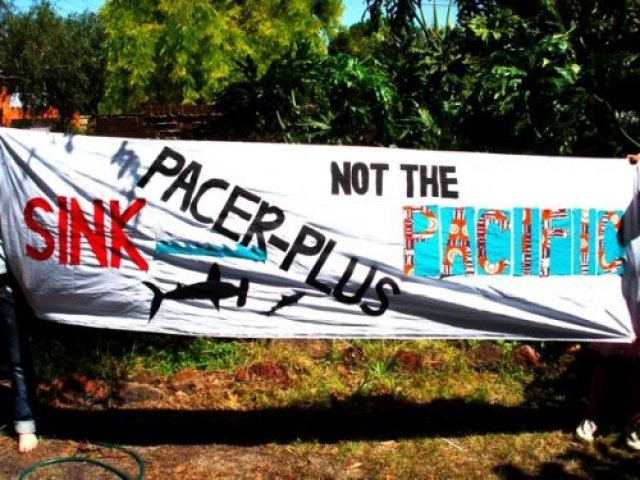
Despite its secrecy and lack of appropriate media coverage, many people have heard about the Trans-Pacific Partnership, the huge free trade agreement being negotiated by some of the biggest economies on the Pacific rim.
Some of it details have been leaked by WikiLeaks, exposing the behind-closed-doors machinations of governments and large corporations.
But very few people have heard about PACER-Plus, a free trade agreement that will include the small island states at the heart of the Pacific.
The sixth inter-sessional meeting on PACER-Plus began in Port Vila, Vanuatu, on March 31. Officials from Australia, New Zealand and other Pacific Islands Forum (PIF) countries hope to resolve issues such as labour mobility and development assistance that have held up previous negotiations.
The original Pacific Agreement on Closer Economic Relations was signed in 2001. It provides better access to Australian and New Zealand markets for the other forum island countries (FICs) ― Cook Islands, Federated States of Micronesia, Kiribati, Nauru, Niue, Palau, Papua New Guinea, Marshall Islands, Samoa, Solomon Islands, Tonga, Tuvalu and Vanuatu.
But it came with the proviso that it would lead to the progressive liberalisation of FIC markets too for their more powerful neighbours.
This led to the start of PACER-Plus negotiations in 2009. An AidWatch report Speaking Truth to Power: Australian and New Zealand Use of Power Politics to Launch Pacific Free Trade Negotiations, revealed the bullying tactics that Australia and NZ employed to get the negotiations started.
There are also concerns about the independence of the PIF secretariat. It relies largely on Australian funding to operate.
To get some sort of indepedence for studies relating to the impacts on FICs of the trade deal, the PIF set up the Office of the Chief Trade Advisor in a bid to avoid the oversight of Canberra and Wellington bureaucrats.
In a statement renewing Australia's commitment to PACER-Plus under the Abbott government, foreign affairs minister Julie Bishop said: “PACER Plus presents an opportunity to encourage Pacific nations to become more integrated. The freer the flow of goods, services, investments and people, the better the prospects for long-term economic growth in Pacific communities.”
If that sounds familiar, its because its the same rhetoric used to support free trade agreements around the world. And like many others, this FTA would pit big economies ― Australia and New Zealand ― against small, vulnerable countries in unequal competition that will indeed see a “free flow” of wealth ― to Australia and New Zealand.
The trade balance between the countries is already unequal. In 2009-'10, Australia imported $3.14 billion worth of goods from FICs and exported $5.7 billion to the FICs. In 2012, New Zealand imported NZ$98 million worth but exported NZ$1 billion.
A trade official told Islands Business in May last year: “The positions adopted by Australia and New Zealand in the negotiations did not match their public pronouncements that they viewed PACER Plus as a trade and development assistance agreement.
“For all intents and purposes, the negotiations were being conducted as if the FICs were developed or advanced developing countries.”
The experience of the North American Free Trade Agreement and other such agreements shows that if FICs remove tariffs on Australian and NZ goods, local industries would be outcompeted by imports from the more developed countries, leading to loss of jobs. This is the “freer flow” and “integration” Bishop wants to see.
Adding to the problem is the fact that many FICs rely heavily on revenue raised from tariffs. These countries already have difficulty funding essential services such as water, health and education. Vanuatu and Tonga could lose up to 17% of their annual government revenue, while Samoa and Kiribati could lose about 14%.
Labour mobility is an important factor in the current negotiations. FICs want Australia and New Zealand to expand their seasonal worker programs, increasing the number of eligible workers and extending to sectors such as accommodation, health care, mining and construction.
For FICs, this would relieve pressure from a growing population and lack of jobs. Remittances are also a key source of foreign exchange for many island economies.
Development assistance is another key area being negotiated. The only reason FICs are even considering the agreement is because PACER Plus is said to be more than just a regular trade agreement, it will include the aim of helping smaller countries with development.
But so far, it seems this development assistance is directed only at helping the FICs implement the agreement. Whether the agreement will extend to genuine development assistance remains to be seen.
For now it seems any development assistance they get will come in the form of the “trickle down” benefits that free trade promises ― and never delivers.
